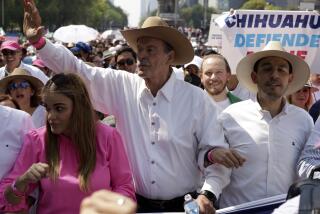Police Who Fired From Hiding Acquitted of Murder : South Africa: The family of a slain bystander, 16, had prosecuted the officers.
Nine policemen and a soldier who hid in a slow-moving, unmarked truck and then opened fire on a crowd of stone throwers and bystanders in 1985 were acquitted of murder Monday by a judge who nevertheless declared the officers’ actions “clearly excessive.”
Judge Deneys Williamson said he found the 10 men and three of their superior officers innocent because there was a “reasonable possibility” that Operation Ghost Vehicle, as the ruse was called, was planned legally--and that the deaths of three bystanders resulted from police “overreaction to a manifestly dangerous situation” rather than from a planned attempt to punish rioting youths. The shooting took place in Athlone, a mixed-race township near Cape Town.
Lawyers for the family of Shaun Magmoed, a 16-year-old bystander killed in the operation, brought the rare private prosecution against the 13 officers after the government declined to try them.
The lawyers relied on the controversial legal doctrine of “common purpose,” which the South African government has used to win death sentences against several dozen black anti-apartheid activists who were present at mob killings but not directly involved.
Williamson said he found “strong indications of a ‘common purpose’ (among the police) to act illegally,” including the fact that innocent people were among the three dead and 15 injured, no warning of any kind was given before opening fire and the police continued to fire even after the stone-throwing ended. But he said the prosecution had failed to prove its case beyond a reasonable doubt, as required by law.
The incident was captured on videotape by a CBS-TV cameraman and shown worldwide, fueling a sanctions drive in the United States and prompting Pretoria to prohibit news coverage of police actions to put down unrest.
The four-month trial was seen as an important test of the country’s judiciary, whose reputation for independence has been sullied by stiff sentences imposed on political activists and a 42-month-old state of emergency that gives police broad, unchecked powers to act against unrest.
“This verdict is going to lead people to the conclusion that there’s no way you can use the system to fight the system,” said attorney Yusuf Ebrahim, a member of the prosecution team.
“It’s our color. That’s the only difference I can see in this case,” Hilary Magmoed, Shaun’s mother, said in an interview after the verdict. “They’ve got the law in their hands. That’s why the world is so upside down.”
Twelve of the defendants are white and one is of mixed race.
The operation, dubbed the “Trojan horse case” by local newspapers, began as a police plan to stop escalating violence in Cape Town townships in 1985. For weeks, government trucks had been struck by rocks, and roads often were closed by barricades of burning tires.
The local police command unit hit on the idea of sending a government delivery truck into the trouble spots with policemen hiding in wooden crates on the back. The intent, the judge said, was to draw an attack and arrest some of the stone-throwers.
On its second trip through the township that day, the truck was pelted with rocks and its windshield broken. The videotape showed that two seconds after the first rock hit, the policemen emerged from the crates and opened fire with pump-action shotguns. They fired 39 rounds of buckshot indiscriminately into a crowd of about 150 people. Only a few in the crowd had actually thrown stones at the truck, and Judge Williamson said Shaun Magmoed was not among them.
An autopsy showed Magmoed’s left side and back were riddled, from his jaw to the sole of his foot, with shotgun pellets. Two other onlookers, ages 11 and 21, died in the street. None of the policemen were injured.
A magisterial inquest into the deaths blamed police negligence, but Atty. Gen. Daniel Rossouw declined to prosecute, saying the officers “didn’t mean to kill anyone.”
A private prosecution team, funded by international human rights groups, brought charges on behalf of the Magmoed family. The prosecutors argued that the only reasonable inference the judge could draw from the evidence was that the police, frustrated by their inability to stop the township violence, had set out to punish those causing trouble.
Because the police used shotguns and the same kind of shells, forensic experts could not link the fatal shots to a specific gun. So the prosecution turned to the doctrine of “common purpose,” under which all defendants who share a criminal intent are equally guilty, regardless of whether they lifted a hand in the killing.
Common purpose was used to convict the five men and a woman known as the Sharpeville Six, who were sentenced to hang for the mob murder of a Lekoa town councilor, even though no evidence was presented that any of the six directly contributed to his death. After hearing worldwide pleas for mercy, President Pieter W. Botha spared the six from the gallows last year.
But Judge Williamson said the rocks thrown at the policemen constituted a “vicious and murderous attack” and that “an armed response, within limits, was justified.” While the police reaction went beyond the bounds of reasonable force, he added, such a reaction in the heat of the moment could not have been foreseen by the police and therefore did not constitute “common purpose.”
More to Read
Start your day right
Sign up for Essential California for news, features and recommendations from the L.A. Times and beyond in your inbox six days a week.
You may occasionally receive promotional content from the Los Angeles Times.







